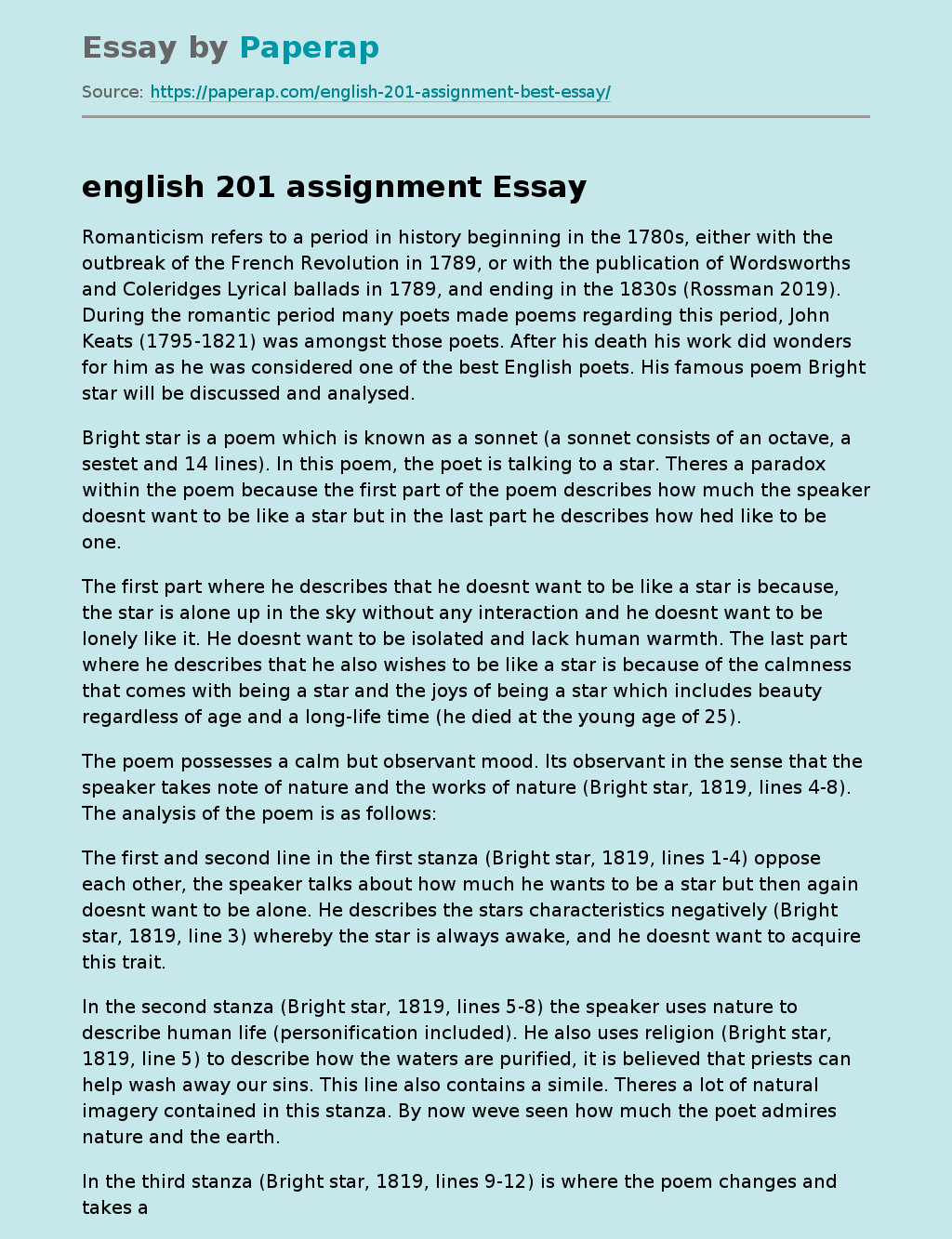Poem Bright Star By John Keats
The following sample essay on Romanticism in Bright Star by John Keats. Romanticism refers to a period in history beginning in the 1780s, either with the outbreak of the French Revolution in 1789, or with the publication of Wordsworths and Coleridges Lyrical ballads in 1789, and ending in the 1830s (Rossman 2019). During the romantic period many poets made poems regarding this period, John Keats (1795-1821) was amongst those poets. After his death his work did wonders for him as he was considered one of the best English poets.
His famous poem Bright star will be discussed and analysed.
Bright star is a poem which is known as a sonnet (a sonnet consists of an octave, a sestet and 14 lines). In this poem, the poet is talking to a star. Theres a paradox within the poem because the first part of the poem describes how much the speaker doesnt want to be like a star but in the last part he describes how hed like to be one.
The first part where he describes that he doesnt want to be like a star is because, the star is alone up in the sky without any interaction and he doesnt want to be lonely like it. He doesnt want to be isolated and lack human warmth. The last part where he describes that he also wishes to be like a star is because of the calmness that comes with being a star and the joys of being a star which includes beauty regardless of age and a long-life time (he died at the young age of 25).
The poem possesses a calm but observant mood. Its observant in the sense that the speaker takes note of nature and the works of nature (Bright star, 1819, lines 4-8). The analysis of the poem is as follows:
The first and second line in the first stanza (Bright star, 1819, lines 1-4) oppose each other, the speaker talks about how much he wants to be a star but then again doesnt want to be alone. He describes the stars characteristics negatively (Bright star, 1819, line 3) whereby the star is always awake, and he doesnt want to acquire this trait.
In the second stanza (Bright star, 1819, lines 5-8) the speaker uses nature to describe human life (personification included). He also uses religion (Bright star, 1819, line 5) to describe how the waters are purified, it is believed that priests can help wash away our sins. This line also contains a simile. Theres a lot of natural imagery contained in this stanza. By now weve seen how much the poet admires nature and the earth.
In the third stanza (Bright star, 1819, lines 9-12) is where the poem changes and takes a paradox turn. The speaker now doesnt see the stars characteristics negatively but, positively. He associates the star to his loved one, he sees that the stars characteristics and qualities can be compared to his loved one. The speaker then expresses his love which is also found in the star (Bright star, 1819, line 11).
In the final stanza (Bright star, 1819, lines 13-14) the speaker emphasizes the love and comfort he receives from the breasts of the loved one and how important the loved one is to him (Bright star, 1819, line 13). The speaker compares the star to his loved one, for it also possesses comfort and beauty no matter the age (Bright star, 1819, line 14). He describes the opposite of death as love (Bright star, 1819, line 14), so you need to choose whether you love or die. The speaker said hed rather be a star and live forever.
The main themes of this poem are Love (Bright star, 1819, line 10), Spiritual (Bright star, 1819, line 5), Isolation (Bright star, 1819, line 2), Nature (Bright star, 1819, lines 4-8). These themes related to romanticism in such a way that the idealisation of romantic love is expressed in the theme of love. The poet was a lone-genius and it is expressed through the nature theme. The art of the poem is spiritual as stated in the spiritual theme. The poet also had a romantic reverence for nature and this is seen through the way he describes, admires and appreciates nature.
This poem is still relevant even today because stars still shine bright in the sky, their sight is one of the most beautiful things to witness. People make wishes upon stars, hoping that itll come true just like how John Keats did. Priests are still known to be the ones that can help with purifying/ washing sins away. Love still exists and people grow old together just like how John Keats said, my fair loves ripening breast (Bright star, 1819, line 10), but theres a gradual increase on people isolating themselves (the poem also covers isolation). The speaker talks and admires nature, theres still nature in the present day although its being compromised and the increase of global warming which is destroying the nature.
In conclusion, this poem is a well written sonnet and has a strong message and the thought behind this poem corresponds with the poem. This poem was written by John Keats for his fianc? as he saw that his days were numbered. The poet was struggling with tuberculosis and compared his life to a stars life, if only he was a star hed live longer because stars live long. Many people might view this poem in different ways and have different understandings/opinions of the poem, but what is very clear is the poets love for nature and the love and importance of his loved one.
Reference page
- Rossman, J. 2019. Moodle lecture slides- What is Romanticism homestudy worksheet)
Poem Bright Star By John Keats. (2019, Nov 25). Retrieved from https://paperap.com/english-201-assignment-best-essay/

